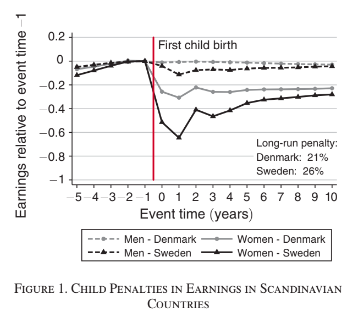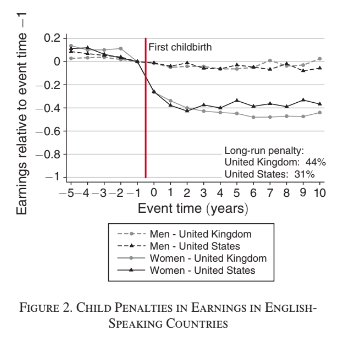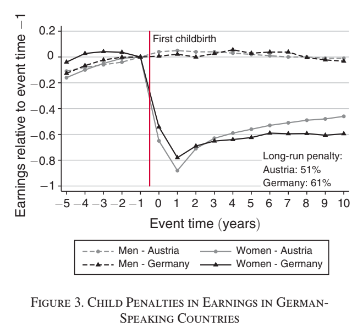By Angela Thissen
I don’t know about you, but I love being a woman. Well, at least most of the time. Recently, while listening to one of my lectures of ECON 133, a class on global inequality & growth, I did not love it, and this is why.



Proceedings. Vol. 109. 2019.
This is the so-called “child penalty”. The figures above simply show the difference in earnings between men and women after the event of having their first child and in different geographical regions. Shockingly, having a child not only decreased earnings by over 80% (!) right after childbirth, but 10 years later there is still a long-run penalty of 50-60% for mothers
working in Austria and Germany. You might wonder whether this is due to some cultural reason – partly yes, but the U.S. is not much better. The immediate penalty amounts to approximately 40%, and after 10 years, a 31% earnings difference for mothers still exists. In comparison, the male parent has basically no difference in earnings along this trajectory. The
obvious question is therefore: What can explain this gender gap? Is it maybe the lack of childcare opportunities locally? Not really, as we can see in many Scandinavian countries which are known to have excellent childcare and extensive parental leave options. While these seem to have positive effects on reducing the penalty, it is still long-lasting and very prevalent.
Were we wrong in assuming that we were on a path of divergence when it comes to gender equality? Well, not completely. It is true that women’s contribution to our economies has received increasing acknowledgement also in the science of economics. Summarized in the branch of feminist economics, new theories try to move away from orthodox economics that
is centered around the ‘rational man’ – our well-known model of the homo economicus who lives his life earning an income, engaging in market transactions, and consuming goods. In the model, he does not do anything else and, most certainly, he does not give birth. If you are still not convinced, think about the basis of our economic growth model – namely GDP. How we measure GDP is taking into account all value that is produced through paid labor, not unpaid labor. Why do we not see unpaid domestic work such as childcare, without which neither our society nor the economy would function at all? The branch of feminist economics therefore attempts to create a model that is more inclusive of factors affecting women that are
ignored in other models. Most of these insights are not necessarily new (the term feminist economics emerged in the 1990’s already), and we should not ignore the policy attention that this topic has received in the past. From gender quotas to parental leave for both mother and father, our governments are actively trying to close the gender gap. But why, then, do we see a picture like above?
What are the reasons for such egregious gender inequality? Firstly, and most simply, women might earn less because they work less as a group. This was in fact one of the main explanations in the last century. However, the labor share produced by women has significantly increased, even though there is still no gender parity in the global labor markets. Reasons for this increase include first and foremost the increase in educational attainment of men vs. women. In fact, the education gap that existed in the last century has reversed. Today, women are more likely to have a higher education. Additionally, factors such as technological substitutes for housework and the birth control pill have made it overall easier for women to work.
Another possible explanation for the gap could be differences in the number of hours women work. Many women work part-time after childbirth, and additionally accumulate fewer working years due to a working break after pregnancy. The following decrease in earnings – a combination of fewer hours worked, less overall experience, and lower wages – is exactly what was depicted earlier in the graphs. For example, a woman might be less incentivized to acquire those specific skills that make you stand out. Think for example about skills that are only specific to one firm, one big customer, etc. – in economic terms, there is less reward for acquiring those skills as you use these less than a male equivalent worker. Put differently, considering that you will apply these skills less, they have a lower return to you. Overall, this is one factor leading to lower wages for women as compared to men.
Consequently, women sort themselves into jobs that are more flexible but pay less. Marianne Bertrand, a researcher from the Chicago School of Economics found some psychological underpinnings to this phenomenon. Behavioral economic theories suggest that women tend to be more risk-averse and at the same time less willing to compete than men. As occupations producing high earnings tend to be more volatile, those psychological attributes make women less likely to choose such jobs and instead choose lower-paying but more stable industries. Overall, this means that women are regularly overrepresented in lower-paying industries.
Women, especially mothers, value flexibility more than men, but well-paid business kind of occupations require very strictly structured working habits. The preference for flexibility – not surprising – is found to be highest for women with young children. The fact that women still have to balance their regular job with non-market jobs such as childcare is still very much present today. In fact, in the U.S. there has even been an opposing force in that regard, as it appears that more educated parents spend more time with their children, possibly because they believe that they can better prepare them for a future in prestigious universities themselves. What adds to this is a behavioral trend experienced in recent years, namely the fact that that as women begin to earn more than their husbands, they will actually increase their share of household-labor. This appears to be used as a mechanism to reinforce gender norms that are disturbed by the man not being the main “bread winner” anymore.
Last but certainly not least is discrimination for which we cannot find any explanations or scientific underpinnings. For the U.S., the Pew Research Center found that 42% of women have experienced some form of gender discrimination. Such situations can range from being treated as less competent than your male counterparts, experiencing smaller slights at work, or being denied a deserved promotion. What we often forget when we say things like ‘the labor market punishes women’ is that the market is not some phenomenon that just magically happens. It is driven by market actors, us humans, that eventually make their own decisions. What we therefore also need – just as much as policy attention – is an extensive mental change in the way that we perceive women in the workforce. The COVID pandemic has shown that the progressiveness we thought we had achieved when it comes to splitting work at home is not at all where we stand today. During the pandemic, most housework and child-care in fact fell on women, significantly pushing us back when it comes to workforce equality and creating a huge burden physically as well as mentally. Hopefully, this will be a wake-up call to further encourage us in working on closing the gap.
No responses yet